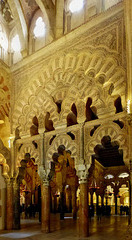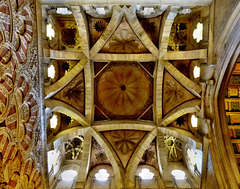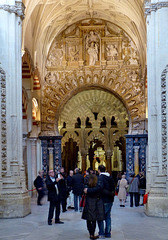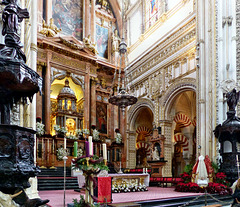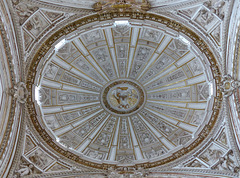
Andalusia / Andalucía
All photos were taken in Andalucía.
Córdoba - Mezquita-Catedral
| |
|
Córdoba shares its history with so many cities in Southern Spain. It was Carthaginian and Roman (from 260BC on), later it belonged to the Byzantine Empire for two decade, got looted by the Vandals, before Visigoths conquered it in 572. In 711 it was taken by the by the Umayyad army and became a provincial capital.
At that time a Christian church erected by the Visigoths was on the site, it was divided and shared by Muslims and Christians. The sharing agreement lasted until 784, when the Christian half was purchased by the Emir Abd al-Rahman I, who then demolished the church and started to build the grand mosque of Córdoba on its ground. This narrative goes back to the tenth-century historian al-Razi.
The work of building the Mezquita employed thousands of artisans and labourers. After the first completion it underwent numerous subsequent changes: Abd al-Rahman II ordered a new minaret, Al-Hakam II enlarged the building and enriched the Mihrab. The Mezquita reached its current dimensions in 987 with the completion of the outer naves and courtyard.
It covers an area of more than 23.000 m².
The Mezquita still is one of the largest sacred buildings on earth. In the 10th century it was in the center of Cordoba, that with a population of upto 500.000, at that time it was one of the largest cities in the known world.
Córdoba - Mezquita-Catedral
| |
|
|
Córdoba shares its history with so many cities in Southern Spain. It was Carthaginian and Roman (from 260BC on), later it belonged to the Byzantine Empire for two decade, got looted by the Vandals, before Visigoths conquered it in 572. In 711 it was taken by the by the Umayyad army and became a provincial capital.
At that time a Christian church erected by the Visigoths was on the site, it was divided and shared by Muslims and Christians. The sharing agreement lasted until 784, when the Christian half was purchased by the Emir Abd al-Rahman I, who then demolished the church and started to build the grand mosque of Córdoba on its ground. This narrative goes back to the tenth-century historian al-Razi.
The work of building the Mezquita employed thousands of artisans and labourers. After the first completion it underwent numerous subsequent changes: Abd al-Rahman II ordered a new minaret, Al-Hakam II enlarged the building and enriched the Mihrab. The Mezquita reached its current dimensions in 987 with the completion of the outer naves and courtyard.
It covers an area of more than 23.000 m².
The Mezquita still is one of the largest sacred buildings on earth. In the 10th century it was in the center of Cordoba, that with a population of upto 500.000, at that time it was one of the largest cities in the known world.
Córdoba - Mezquita-Catedral
| |
|
|
|
Córdoba shares its history with so many cities in Southern Spain. It was Carthaginian and Roman (from 260BC on), later it belonged to the Byzantine Empire for two decade, got looted by the Vandals, before Visigoths conquered it in 572. In 711 it was taken by the by the Umayyad army and became a provincial capital.
At that time a Christian church erected by the Visigoths was on the site, it was divided and shared by Muslims and Christians. The sharing agreement lasted until 784, when the Christian half was purchased by the Emir Abd al-Rahman I, who then demolished the church and started to build the grand mosque of Córdoba on its ground. This narrative goes back to the tenth-century historian al-Razi.
The work of building the Mezquita employed thousands of artisans and labourers. After the first completion it underwent numerous subsequent changes: Abd al-Rahman II ordered a new minaret, Al-Hakam II enlarged the building and enriched the Mihrab. The Mezquita reached its current dimensions in 987 with the completion of the outer naves and courtyard.
It covers an area of more than 23.000 m².
The Mezquita still is one of the largest sacred buildings on earth. In the 10th century it was in the center of Cordoba, that with a population of upto 500.000, at that time it was one of the largest cities in the known world.
After in 1236 Córdoba was captured from the Moors, the Christians initially left the architecture Mezquita undisturbed.
The just consecrated it, dedicated it to the Virgin Mary, and used it as a place of Christian worship. Later small chapels were inserted and the the minaret was converted into a the bell tower of the cathedral.
The most significant alteration was the building of a Renaissance cathedral in a cruciform layout right ine center of the former mosque. The insertion was constructed by permission of Charles V, King of Castile and Aragon.
The legend tells, that upon seeing it completed, he remarked, "You have built here what you or anyone might have built anywhere else, but you have destroyed what was unique in the world."
Here in the foreground is an arch, belonging the the "new" cathedral, while in the backdrop is a part of the "old" mosque.
Córdoba - Mezquita-Catedral
| |
|
|
Córdoba shares its history with so many cities in Southern Spain. It was Carthaginian and Roman (from 260BC on), later it belonged to the Byzantine Empire for two decade, got looted by the Vandals, before Visigoths conquered it in 572. In 711 it was taken by the by the Umayyad army and became a provincial capital.
At that time a Christian church erected by the Visigoths was on the site, it was divided and shared by Muslims and Christians. The sharing agreement lasted until 784, when the Christian half was purchased by the Emir Abd al-Rahman I, who then demolished the church and started to build the grand mosque of Córdoba on its ground. This narrative goes back to the tenth-century historian al-Razi.
The work of building the Mezquita employed thousands of artisans and labourers. After the first completion it underwent numerous subsequent changes: Abd al-Rahman II ordered a new minaret, Al-Hakam II enlarged the building and enriched the Mihrab. The Mezquita reached its current dimensions in 987 with the completion of the outer naves and courtyard.
It covers an area of more than 23.000 m².
The Mezquita still is one of the largest sacred buildings on earth. In the 10th century it was in the center of Cordoba, that with a population of upto 500.000, at that time it was one of the largest cities in the known world.
After in 1236 Córdoba was captured from the Moors, the Christians initially left the architecture Mezquita undisturbed.
They just consecrated it, dedicated it to the Virgin Mary, and used it as a place of Christian worship. Later small chapels were inserted and the the minaret was converted into a the bell tower of the cathedral.
The most significant alteration was the building of a Renaissance cathedral in a cruciform layout right in the center of the former mosque. The insertion was constructed by permission of Charles V, King of Castile and Aragon.
The legend tells, that upon seeing it completed, he remarked, "You have built here what you or anyone might have built anywhere else, but you have destroyed what was unique in the world."
Córdoba - Mezquita-Catedral
| |
|
|
Córdoba shares its history with so many cities in Southern Spain. It was Carthaginian and Roman (from 260BC on), later it belonged to the Byzantine Empire for two decade, got looted by the Vandals, before Visigoths conquered it in 572. In 711 it was taken by the by the Umayyad army and became a provincial capital.
At that time a Christian church erected by the Visigoths was on the site, it was divided and shared by Muslims and Christians. The sharing agreement lasted until 784, when the Christian half was purchased by the Emir Abd al-Rahman I, who then demolished the church and started to build the grand mosque of Córdoba on its ground. This narrative goes back to the tenth-century historian al-Razi.
The work of building the Mezquita employed thousands of artisans and labourers. After the first completion it underwent numerous subsequent changes: Abd al-Rahman II ordered a new minaret, Al-Hakam II enlarged the building and enriched the Mihrab. The Mezquita reached its current dimensions in 987 with the completion of the outer naves and courtyard.
It covers an area of more than 23.000 m².
The Mezquita still is one of the largest sacred buildings on earth. In the 10th century it was in the center of Cordoba, that with a population of upto 500.000, at that time it was one of the largest cities in the known world.
After in 1236 Córdoba was captured from the Moors, the Christians initially left the architecture Mezquita undisturbed.
They just consecrated it, dedicated it to the Virgin Mary, and used it as a place of Christian worship. Later small chapels were inserted and the the minaret was converted into a the bell tower of the cathedral.
The most significant alteration was the building of a Renaissance cathedral in a cruciform layout right in the center of the former mosque. The insertion was constructed by permission of Charles V, King of Castile and Aragon.
The legend tells, that upon seeing it completed, he remarked, "You have built here what you or anyone might have built anywhere else, but you have destroyed what was unique in the world."
Córdoba - Mezquita-Catedral
| |
|
|
Córdoba shares its history with so many cities in Southern Spain. It was Carthaginian and Roman (from 260BC on), later it belonged to the Byzantine Empire for two decade, got looted by the Vandals, before Visigoths conquered it in 572. In 711 it was taken by the by the Umayyad army and became a provincial capital.
At that time a Christian church erected by the Visigoths was on the site, it was divided and shared by Muslims and Christians. The sharing agreement lasted until 784, when the Christian half was purchased by the Emir Abd al-Rahman I, who then demolished the church and started to build the grand mosque of Córdoba on its ground. This narrative goes back to the tenth-century historian al-Razi.
The work of building the Mezquita employed thousands of artisans and labourers. After the first completion it underwent numerous subsequent changes: Abd al-Rahman II ordered a new minaret, Al-Hakam II enlarged the building and enriched the Mihrab. The Mezquita reached its current dimensions in 987 with the completion of the outer naves and courtyard.
It covers an area of more than 23.000 m².
The Mezquita still is one of the largest sacred buildings on earth. In the 10th century it was in the center of Cordoba, that with a population of upto 500.000, at that time it was one of the largest cities in the known world.
After in 1236 Córdoba was captured from the Moors, the Christians initially left the architecture Mezquita undisturbed.
They just consecrated it, dedicated it to the Virgin Mary, and used it as a place of Christian worship. Later small chapels were inserted and the the minaret was converted into a the bell tower of the cathedral.
The most significant alteration was the building of a Renaissance cathedral in a cruciform layout right in the center of the former mosque. The insertion was constructed by permission of Charles V, King of Castile and Aragon.
The legend tells, that upon seeing it completed, he remarked, "You have built here what you or anyone might have built anywhere else, but you have destroyed what was unique in the world."
Santiago (Saint Jaques) in his role as "Matamoro".
Córdoba - Mezquita-Catedral
| |
|
|
Córdoba shares its history with so many cities in Southern Spain. It was Carthaginian and Roman (from 260BC on), later it belonged to the Byzantine Empire for two decade, got looted by the Vandals, before Visigoths conquered it in 572. In 711 it was taken by the by the Umayyad army and became a provincial capital.
At that time a Christian church erected by the Visigoths was on the site, it was divided and shared by Muslims and Christians. The sharing agreement lasted until 784, when the Christian half was purchased by the Emir Abd al-Rahman I, who then demolished the church and started to build the grand mosque of Córdoba on its ground. This narrative goes back to the tenth-century historian al-Razi.
The work of building the Mezquita employed thousands of artisans and labourers. After the first completion it underwent numerous subsequent changes: Abd al-Rahman II ordered a new minaret, Al-Hakam II enlarged the building and enriched the Mihrab. The Mezquita reached its current dimensions in 987 with the completion of the outer naves and courtyard.
It covers an area of more than 23.000 m².
The Mezquita still is one of the largest sacred buildings on earth. In the 10th century it was in the center of Cordoba, that with a population of upto 500.000, at that time it was one of the largest cities in the known world.
After in 1236 Córdoba was captured from the Moors, the Christians initially left the architecture Mezquita undisturbed.
They just consecrated it, dedicated it to the Virgin Mary, and used it as a place of Christian worship. Later small chapels were inserted and the the minaret was converted into a the bell tower of the cathedral.
The most significant alteration was the building of a Renaissance cathedral in a cruciform layout right in the center of the former mosque. The insertion was constructed by permission of Charles V, King of Castile and Aragon.
The legend tells, that upon seeing it completed, he remarked, "You have built here what you or anyone might have built anywhere else, but you have destroyed what was unique in the world."
Córdoba - Mezquita-Catedral
| |
|
|
Córdoba shares its history with so many cities in Southern Spain. It was Carthaginian and Roman (from 260BC on), later it belonged to the Byzantine Empire for two decade, got looted by the Vandals, before Visigoths conquered it in 572. In 711 it was taken by the by the Umayyad army and became a provincial capital.
At that time a Christian church erected by the Visigoths was on the site, it was divided and shared by Muslims and Christians. The sharing agreement lasted until 784, when the Christian half was purchased by the Emir Abd al-Rahman I, who then demolished the church and started to build the grand mosque of Córdoba on its ground. This narrative goes back to the tenth-century historian al-Razi.
The work of building the Mezquita employed thousands of artisans and labourers. After the first completion it underwent numerous subsequent changes: Abd al-Rahman II ordered a new minaret, Al-Hakam II enlarged the building and enriched the Mihrab. The Mezquita reached its current dimensions in 987 with the completion of the outer naves and courtyard.
It covers an area of more than 23.000 m².
The Mezquita still is one of the largest sacred buildings on earth. In the 10th century it was in the center of Cordoba, that with a population of upto 500.000, at that time it was one of the largest cities in the known world.
After in 1236 Córdoba was captured from the Moors, the Christians initially left the architecture Mezquita undisturbed.
They just consecrated it, dedicated it to the Virgin Mary, and used it as a place of Christian worship. Later small chapels were inserted and the the minaret was converted into a the bell tower of the cathedral.
The most significant alteration was the building of a Renaissance cathedral in a cruciform layout right in the center of the former mosque. The insertion was constructed by permission of Charles V, King of Castile and Aragon.
The legend tells, that upon seeing it completed, he remarked, "You have built here what you or anyone might have built anywhere else, but you have destroyed what was unique in the world."
Córdoba - Mezquita-Catedral
| |
|
Córdoba shares its history with so many cities in Southern Spain. It was Carthaginian and Roman (from 260BC on), later it belonged to the Byzantine Empire for two decade, got looted by the Vandals, before Visigoths conquered it in 572. In 711 it was taken by the by the Umayyad army and became a provincial capital.
At that time a Christian church erected by the Visigoths was on the site, it was divided and shared by Muslims and Christians. The sharing agreement lasted until 784, when the Christian half was purchased by the Emir Abd al-Rahman I, who then demolished the church and started to build the grand mosque of Córdoba on its ground. This narrative goes back to the tenth-century historian al-Razi.
The work of building the Mezquita employed thousands of artisans and labourers. After the first completion it underwent numerous subsequent changes: Abd al-Rahman II ordered a new minaret, Al-Hakam II enlarged the building and enriched the Mihrab. The Mezquita reached its current dimensions in 987 with the completion of the outer naves and courtyard.
It covers an area of more than 23.000 m².
The Mezquita still is one of the largest sacred buildings on earth. In the 10th century it was in the center of Cordoba, that with a population of upto 500.000, at that time it was one of the largest cities in the known world.
After in 1236 Córdoba was captured from the Moors, the Christians initially left the architecture Mezquita undisturbed.
They just consecrated it, dedicated it to the Virgin Mary, and used it as a place of Christian worship. Later small chapels were inserted and the the minaret was converted into a the bell tower of the cathedral.
The most significant alteration was the building of a Renaissance cathedral in a cruciform layout right in the center of the former mosque. The insertion was constructed by permission of Charles V, King of Castile and Aragon.
The legend tells, that upon seeing it completed, he remarked, "You have built here what you or anyone might have built anywhere else, but you have destroyed what was unique in the world."
Córdoba - Mezquita-Catedral
| |
|
Córdoba shares its history with so many cities in Southern Spain. It was Carthaginian and Roman (from 260BC on), later it belonged to the Byzantine Empire for two decade, got looted by the Vandals, before Visigoths conquered it in 572. In 711 it was taken by the by the Umayyad army and became a provincial capital.
At that time a Christian church erected by the Visigoths was on the site, it was divided and shared by Muslims and Christians. The sharing agreement lasted until 784, when the Christian half was purchased by the Emir Abd al-Rahman I, who then demolished the church and started to build the grand mosque of Córdoba on its ground. This narrative goes back to the tenth-century historian al-Razi.
The work of building the Mezquita employed thousands of artisans and labourers. After the first completion it underwent numerous subsequent changes: Abd al-Rahman II ordered a new minaret, Al-Hakam II enlarged the building and enriched the Mihrab. The Mezquita reached its current dimensions in 987 with the completion of the outer naves and courtyard.
It covers an area of more than 23.000 m².
The Mezquita still is one of the largest sacred buildings on earth. In the 10th century it was in the center of Cordoba, that with a population of upto 500.000, at that time it was one of the largest cities in the known world.
After in 1236 Córdoba was captured from the Moors, the Christians initially left the architecture Mezquita undisturbed.
The just consecrated it, dedicated it to the Virgin Mary, and used it as a place of Christian worship. Later small chapels were inserted and the the minaret was converted into a the bell tower of the cathedral.
The most significant alteration was the building of a Renaissance cathedral in a cruciform layout right in the center of the former mosque.
The brick-and-stone striped arches are supported by 856 granite and marble pillars, coming from Romans and Visigothic ruins. Many of them are dotted with small carved graffiti. They may date to the time, when the mosque was taken by the Christian troops. Of course they could as well be much older - or younger.
Córdoba - Mezquita-Catedral
| |
|
Córdoba shares its history with so many cities in Southern Spain. It was Carthaginian and Roman (from 260BC on), later it belonged to the Byzantine Empire for two decade, got looted by the Vandals, before Visigoths conquered it in 572. In 711 it was taken by the by the Umayyad army and became a provincial capital.
At that time a Christian church erected by the Visigoths was on the site, it was divided and shared by Muslims and Christians. The sharing agreement lasted until 784, when the Christian half was purchased by the Emir Abd al-Rahman I, who then demolished the church and started to build the grand mosque of Córdoba on its ground. This narrative goes back to the tenth-century historian al-Razi.
The work of building the Mezquita employed thousands of artisans and labourers. After the first completion it underwent numerous subsequent changes: Abd al-Rahman II ordered a new minaret, Al-Hakam II enlarged the building and enriched the Mihrab. The Mezquita reached its current dimensions in 987 with the completion of the outer naves and courtyard.
It covers an area of more than 23.000 m².
The Mezquita still is one of the largest sacred buildings on earth. In the 10th century it was in the center of Cordoba, that with a population of upto 500.000, at that time it was one of the largest cities in the known world.
After in 1236 Córdoba was captured from the Moors, the Christians initially left the architecture Mezquita undisturbed.
The just consecrated it, dedicated it to the Virgin Mary, and used it as a place of Christian worship. Later small chapels were inserted and the the minaret was converted into a the bell tower of the cathedral.
The most significant alteration was the building of a Renaissance cathedral in a cruciform layout right in the center of the former mosque.
The brick-and-stone striped arches are supported by 856 granite and marble pillars, coming from Romans and Visigothic ruins. Many of them are dotted with small carved graffiti. They may date to the time, when the mosque was taken by the Christian troops. Of course they could as well be much older - or younger.
Córdoba - Convento de Santa Clara
| |
|
|
Córdoba shares its history with so many cities in Southern Spain. It was Carthaginian and Roman (from 260BC on), later it belonged to the Byzantine Empire for two decade, got looted by the Vandals, before Visigoths conquered it in 572. In 711 it was taken by the by the Umayyad army and became a provincial capital.
In 976 a mosque was built here atop of a Christian church erected by the Visigoths. After the Reconquista the mosque was coverted into a nunnery and a basilica was built.
Córdoba - Convento de Santa Clara
| |
|
Córdoba shares its history with so many cities in Southern Spain. It was Carthaginian and Roman (from 260BC on), later it belonged to the Byzantine Empire for two decade, got looted by the Vandals, before Visigoths conquered it in 572. In 711 it was taken by the by the Umayyad army and became a provincial capital.
In 976 a mosque was built here atop of a Christian church erected by the Visigoths. After the Reconquista the mosque was coverted into a nunnery and a basilica was built. The Moorish minaret of the former mosque survived the times.
Córdoba - Teatro Gongora
| |
|
|
Córdoba was captured by King Ferdinand III of Castile in 1236, after a siege of several months. The city declined over the next centuries and was partly destroyed and looted by French troops in 1808 during the Peninsular War.
Today Córdoba is a thriving city with a population of more than 300.000. The "Teatro Gongora" was built 1929 - 1932 and once was a cinema.
teatrocordoba.es/recintos/teatro-gongora
Córdoba - Plaza de las Tendillas
| |
|
Córdoba was captured by King Ferdinand III of Castile in 1236, after a siege of several months. The city declined over the next centuries and was partly destroyed and looted by French troops in 1808 during the Peninsular War.
Today Córdoba is a thriving city with a population of more than 300.000. The elegant "Plaza de las Tendillas" is the place, where the tourists meet. Even in December.
Córdoba - Minaret of San Juan
| |
|
|
Córdoba shares its history with so many cities in Southern Spain. It was Carthaginian and Roman (from 260BC on), later it belonged to the Byzantine Empire for two decade, got looted by the Vandals, before Visigoths conquered it in 572. In 711 it was taken by the by the Umayyad army and became a provincial capital.
Córdoba was captured by King Ferdinand III of Castile in 1236, after a siege of several months. The city declined over the next centuries and was partly destroyed and looted by French troops in 1808 during the Peninsular War.
Today Córdoba is a thriving city with a population of more than 300.000. The Minaret of San Juan (aka "Torre de San Juan") was built end of the 9th or early 10th century and was then part of a mosque. It was probably higher, than it is now. After the conquest of Cordoba the place was ceded to the Knights Hospitaller (aka "of Saint John of Jerusalem"), who built a church on the ruins of the mosque.
Antequera - Alcazaba
| |
|
|
|
Antequera was known during Roman times as "Anticaria" and had existed already centuries, when the Romans took over the area from the Carthaginians after the Punic Wars. During the fall of the Roman Empire, the area fell to the Vandals in the 410s. They were attacked by the Visigoths, who incarporated it into the Visigothic Kingdom.
During the Arab invasion Anticaria was conquered around 716 and, when the Reconquista rolled south, it became one of the northern cities of the remaining Nasrid kingdom of Granada. Fortifications were built and a Moorish castle, named Alcazaba, erected. For about two hundred years the Medina, located inside the Alcazaba, was attacked repeatedly. In 1410, an army led by Prince Ferdinand of Aragon conquered it.
Antequera became part of the Kingdom of Castile, the Muslims were driven out. The city became a Catholic fortress against the Nasrid kingdom of Granada, and a base for continuing conquest. After Granada, the last Moorish city, capitulated in 1492, Antequera began to recover from the centuries of fighting.
The "Alcazaba de Antequera" towers over Antequera. It was built in the 14th century over Roman ruins got reinforced after the conquest was used by the Catholic armees.
El Torcal de Antequera
| |
|
|
|
The "Sierra del Torca" is a small mountain range separating Antequera and Malaga. El Torcal de Antequera is a nature reserve, an area of about 17 square kilometres. Here are impressive karst landscapes.
Jump to top
RSS feed- Latest items - Subscribe to the latest items added to this album
- ipernity © 2007-2025
- Help & Contact
|
Club news
|
About ipernity
|
History |
ipernity Club & Prices |
Guide of good conduct
Donate | Group guidelines | Privacy policy | Terms of use | Statutes | In memoria -
Facebook
Twitter

